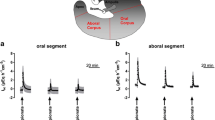Abstract.
The synthesis and release of non-neuronal acetylcholine, a widely expressed signaling molecule, were investigated in the human placenta. This tissue is free of cholinergic neurons, i.e. a contamination of neuronal acetylcholine can be excluded. The villus showed a choline acetyltransferase (ChAT) activity of 0.65 nmol/mg protein per h and contained 500 nmol acetylcholine/g dry weight. In the absence of cholinesterase inhibitors the release of acetylcholine from isolated villus pieces amounted to 1.3 nmol/g wet weight per 10 min corresponding to a fractional release rate of 0.13% per min. The following substances did not significantly modify the release of acetylcholine: oxotremorine (1 µM), scopolamine (1 µM), (+)-tubocurarine (30 µM), forskolin (30 µM), ouabain (10 µM), 4α-phorbol 12,13-didecanoate (1 µM) and tetrodotoxin (1 µM). Removal of extracellular calcium, phorbol 12,13-dibutyrate (1 µM) and colchicine (100 µM) reduced the acetylcholine release between 30% and 50%. High potassium chloride (54 mM and 108 mM) increased the acetylcholine release slightly (by about 30%). A concentration of 10 µM nicotine was ineffective, but 100 µM nicotine enhanced acetylcholine release gradually over a 50-min period without desensitization of the response. The facilitatory effect of nicotine was prevented by 30 µM (+)-tubocurarine. Inhibitors of cholinesterase (physostigmine, neostigmine; 3 µM) facilitated the efflux of acetylcholine about sixfold, and a combination of both (+)-tubocurarine (30 µM) and scopolamine (1 µM) halved the enhancing effect. In conclusion, release mechanisms differ between non-neuronal and neuronal acetylcholine. Facilitatory nicotine receptors are present which are activated by applied nicotine or by blocking cholinesterase. Thus, cholinesterase inhibitors increase assayed acetylcholine by two mechanisms, protection of hydrolysis and stimulation of facilitatory nicotine receptors.
Similar content being viewed by others
Author information
Authors and Affiliations
Additional information
Electronic Publication
Rights and permissions
About this article
Cite this article
Wessler, I., Roth, E., Schwarze, S. et al. Release of non-neuronal acetylcholine from the human placenta: difference to neuronal acetylcholine. Naunyn-Schmied Arch Pharmacol 364, 205–212 (2001). https://doi.org/10.1007/s002100100445
Received:
Accepted:
Issue Date:
DOI: https://doi.org/10.1007/s002100100445




